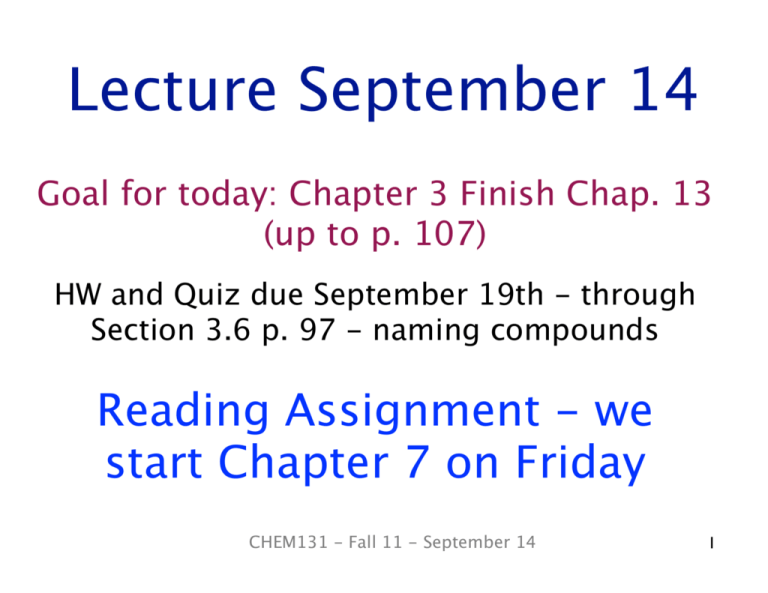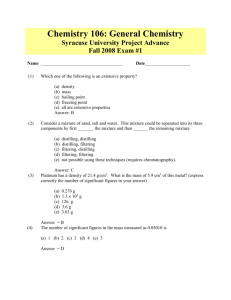by mass
advertisement

Lecture September 14 Goal for today: Chapter 3 Finish Chap. 13 (up to p. 107) HW and Quiz due September 19th - through Section 3.6 p. 97 - naming compounds Reading Assignment - we start Chapter 7 on Friday CHEM131 - Fall 11 - September 14 1 Example (I) How many CaCO3 molecules are in 0.5632 g? Molar mass CaCO3 = 40.08 + 12.01 + 3(16.00) = 100.09 # molecules = 0.5632g (1 mol/100.09 g) (6.022 x 1023 molecules/ mol) = ➘ Answer: 3.389 x 1021 molecules CaCO3 What is the percentage (by mass) of Ca in CaCO3? Mass of Ca / mass of CaCO3 = 40.08/100.09 Answer: 40.046% by mass How many Ca atoms are in 0.5632 g of CaCO3? # Ca atoms = [(0.5632 x .40046)/40.078] x 6.022x1023 ➚ Answer: 3.389 x 1021 atoms of Ca CHEM131 - Fall 11 - September 14 2 Percent Composition and Chemical Formula Using Oxalic acid H2C2O4 as an example molar mass: 2 x 1.008 = 2 x 12.011 = 4 x 16.00 = Total = 2.016 24.022 64.00 90.04 g/mol Can calculate %O from the H and C % H = (2.016/90.04)x100 = 2.239% % C = (24.022/90.04)x100 = 26.68% % O= (64.00/90.04)x100 =71.08% CHEM131 - Fall 11 - September 14 3 Question? What mass of carbon is in 25.0 g of oxalic acid? mass C = 25.0 g acid (1 mol acid/90.04 g acid) (2 mol C/1 mol acid) (12.011 g C/1 mol C) = 6.67 g C OR (from previous slide C 26.68%) 25.0 (.2668 C) = 6.67 g C in oxalic acid CHEM131 - Fall 11 - September 14 4 Empirical Formulas Using the % by mass A compound containing calcium and oxygen is 71.47 % Ca, what is the empirical formula of the compound? 1) Assume 100.00 g of compound. Ca:O 1:1 CaO 2) Calculate the moles of Ca moles Ca = 71.47 g (1 mol/40.08 g) = 1.783 mol 3) Find the mass and then moles of oxygen moles O = (100.00-71.47)g (1 mol/16.00 g) = 1.783 4) Find the ratio of the elements ☞ formula CHEM131 - Fall 11 - September 14 5 Empirical Formula Example A compound with a molar mass of 82 g/mol has been determined to contain 14.6% C, 39.0% O and 46.3% F, what are the empirical and molecular formulas? Assume 100 g sample 14.6 g/12.01 = 1.22 moles C 39.0 g/16.00 = 2.44 moles O 46.3/19.00 = 2.44 moles F C:O:F = 1:2:2 CO2F2 empirical formula 12.00 + 2(16.00) + 2(19.00) = 82 molar mass = 82 so this is also the molecular formula! CHEM131 - Fall 11 - September 14 6 One More Example Magnesium citrate (MgC6H6O7 molecular weight = 214.41) is used as a nutritional Mg supplement. What mass of magnesium citrate is needed to supply 400. mg of Mg? % Mg = (24.31/214.41)x100 = 11.34% Mg Mass of magnesium citrate = 0.400 g Mg (214.41 g citrate/24.31 g Mg) = 0.400/.1134 = 3.53 g citrate CHEM131 - Fall 11 - September 14 7 Quiz of the Day What is the empirical formula of a compound with the following % composition 37.48% C 12.58% H 49.94% O Assume 100.00 g # moles C = 37.48/12.01 = 3.12 # moles H = 12.58/1.008 = 12.48 # moles O = 49.94/16.00 = 3.12 C:H:O = 1:4:1 CH4O CHEM131 - Fall 11 - September 14 8









